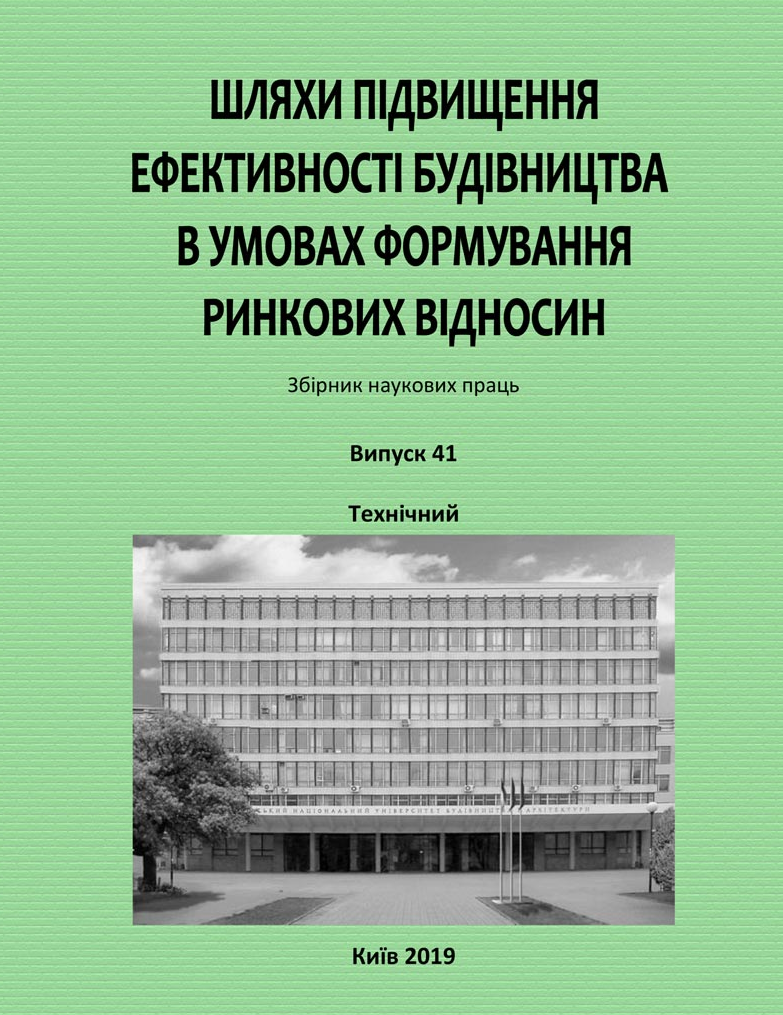Dependence of the energy efficiency class of a building on the type of translucent constructions
DOI:
https://doi.org/10.32347/2707-501x.2019.41.89-98Keywords:
translucent constructions, energy efficiency class of a building, heating, insulating glass (IG), thermal resistance, energy consumption of buildingsAbstract
The issues of energy efficiency of translucent structures and two methods for determining the energy consumption of a building, the classification of buildings by energy efficiency, the feasibility of using better translucent fencing structures are considered.
It is established that the energy consumption of buildings is determined in two ways: calculated and based on actual energy consumption according to the data of meters or other metering devices. As a rule, the calculation method is applied to new buildings, reconstructed and capital reconstructed buildings on the basis of project documentation. Determining the actual energy consumption of existing buildings according to metering devices has one major drawback – if the building is constantly under-receiving heat energy, then its energy consumption, determined by metering devices, will be lowered, which will lead to further errors in determining the energy efficiency class.
The ways of choosing energy efficient windows are considered, it is established that accessories and sealing elements are an important element of an energy efficient window. Efficiency of keeping heat in winter, cold in summer combined with the absence of drafts and noise depends on their quality, perfection of structure and functionality. The energy-efficient window provides permeability to the solar radiation room and passive heating, the necessary air exchange, the reflection and preservation of the radiative heat of the enclosing structures in the room and to save heat. Energy saving due to the installation of such a window is about 230 kWh / m² of its surface during the heating period (0.197 Gcal / m² of the window).
The definitions of the estimated and actual specific annual energy consumption of the building are given. Two methods of calculating the energy consumption of a building are considered. In the course of the research, data on translucent structures, their advantages and disadvantages, energy efficiency requirements for buildings were collected. Significant reduction of material and energy resources is achieved due to the complex thermo-modernization of the housing stock. The analysis of mathematical models of the energy performance of a building, depending on the thermal characteristics of the external enclosure structures, is the basis for the assessment of residential buildings by the criterion of energy efficiency for compliance with the requirements of sustainable development.
References
Requirements for the energy efficiency indicator // DBN B.2.6-31: 2016 "Thermal insulation of buildings". - pp. 9-13. - URL: https://dbn.co.ua/dbn/DBN_V.2.6-31-2016_Teplova_izolyatsiya_budively.pdf.
Law of Ukraine "On Energy Efficiency of Buildings" of 22.06.2017 No. 2118-VIII. URL: https://zakon.rada.gov.ua/laws/show/2118-19.
Choosing a method of conducting energy audit // DSTU B В.2.2-39: 2016 «Buildings and structures. Methods and stages of conducting energy audits of buildings”. - pp. 3-5. - URL: https://dbn/co/ua/load/normativy/dstu/dstu_b_v_2_2_39 _39_2016_metodi_ta_etapi_producting_energetichnogo_auditu_budivel/5-1-0-1754.
Methods for calculating energy consumption // DSTU B EN ISO 13790: 2011 “Energy efficiency of buildings. Calculation of Opera and Cooling (ENISO 13790: 2008, IDT). - pp. 199-202. - URL:https://dbn.co.ua/load/normativy/dstu/dstu_b_eu_is o_13790/5-1-0-1159.
Technical requirements // DSTU BV.2.6-17- 2000 (GOST 26602.1-99) "Design of buildings and structures. Window and door blocks. Methods for determining heat transfer resistance”. - pp. 7-14. - URL: http://www.accbud.ua/spravochnik/standarty-i-normativy/dstu/okna--dveri/dstu-b-v-2-6-17-2000.
Natural lighting // DBN B.2.5-28-2006 "Natural and artificial lighting". - pp. 12-15. - URL: http://www.gorsvet.kiev.ua/wp-content/uploads/2016/08/%D0%94%D0% 91%D0%9D-%D0%92.2.5-28-2006.pdf.
Evaluation of inefficient buildings // DSTU-N B А.2.2-13: 2015 “Energy efficiency of buildings. Guidelines for the energy assessment of buildings. - pp. 5-7. - URL: https://thermomodernisation.org/wp-content/uploads/2017/11/1783_-__.2.2-13_2015.pdf.
Energy efficiency of buildings in Ukraine. URL:http://dergbud.org.ua/enerhoefekty vnist-budivelua.html.
How to evaluate the energy efficiency of a home. URL:https://energoefficiency.in. ua/full-articles/12-yak-otsiniti-energetichnu-efektivnist-budinku.
Izmailova, K.V. (2018) Ekolohichnyi suprovid zapasiv yak chynnyk efektyvnosti vykorystannia oborotnykh zasobiv budivelnoho pidpryiemstva. Shliakhy pidvyshchennia efektyvnosti budivnytstva v umovakh formuvannia rynkovykh vidnosyn. 36. 3 – 7.
Kishchenko, Tetiana, Husarova, Larysa & Bolila, Nadiia (2018). Osoblyvosti ekonomichnoi otsinky zvedennia budynkiv z nyzkym enerhozberezhenniam. Shliakhy pidvyshchennia efektyvnosti budivnytstva v umovakh formuvannia rynkovykh vidnosyn, 36, 57 – 61.
Enerhoefektyvnist v munitsypalnomu sektori. Navchalnyi posibnyk dlia posadovykh osib mistsevoho samovriaduvannia (2015) / Maksymov A.S., Vakhovych I.V., ta inshi. - Asotsiatsiia mist Ukrainy. Proekt USAID DIALOH.
Bielienkova, O.Iu., Ostapenko, I.O. (2013) Ekonomichna otsinka zakhodiv z pidvyshchennia enerhoefektyvnosti. Budivelne vyrobnytstvo. 55. 28 - 31.
Abashkyna, K.O. & Izmailova, K.V. (2017) Obhruntuvannia ekonomichnoi dotsilnosti vstanovlennia soniachnykh batarei na zamiskykh zhytlovykh budynkakh/ Budivelne vyrobnytstvo. 62 / 2
Downloads
How to Cite
Issue
Section
License
Copyright (c) 2020 S. Burba

This work is licensed under a Creative Commons Attribution 4.0 International License.
Authors who publish with this journal agree to the following terms:
- Authors retain copyright and grant the journal right of first publication with the work simultaneously licensed under a Creative Commons Attribution License that allows others to share the work with an acknowledgement of the work's authorship and initial publication in this journal.
- Authors are able to enter into separate, additional contractual arrangements for the non-exclusive distribution of the journal's published version of the work (e.g., post it to an institutional repository or publish it in a book), with an acknowledgement of its initial publication in this journal.
- Authors are permitted and encouraged to post their work online (e.g., in institutional repositories or on their website) prior to and during the submission process, as it can lead to productive exchanges, as well as earlier and greater citation of published work (See The Effect of Open Access).

